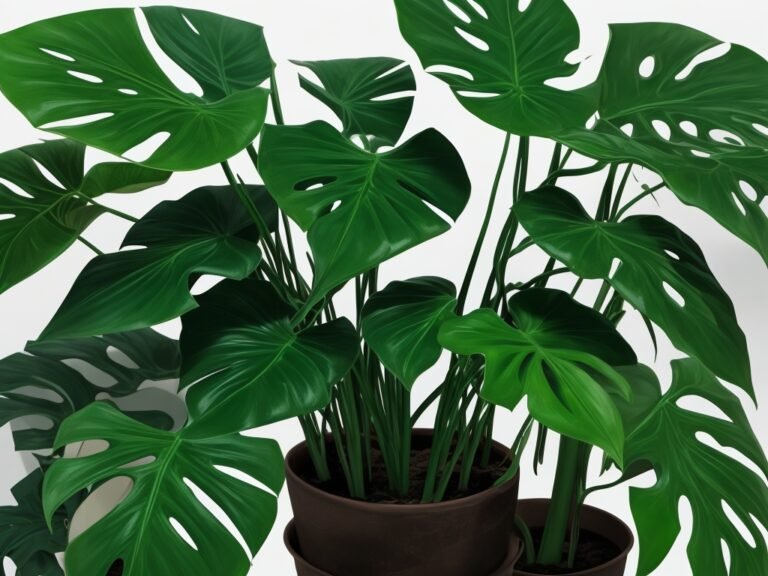How To Treat Mealybugs On Monstera Leaves?
Key Takeaways:
- Use rubbing alcohol or neem oil to kill mealybugs on Monstera leaves.
- Remove heavily infested leaves to prevent mealybug spread.
- Maintain a clean and well-ventilated environment to discourage mealybug infestation.
- Consider introducing natural predators like ladybugs to control mealybug population.
Are those pesky white cotton-like pests invading your beloved Monstera leaves?
Don’t worry, I’ve got you covered! In this article, we’ll dive into the world of mealybugs and their impact on your Monstera plant.
From identifying the signs of infestation to preventing future attacks, I’ll share my expertise and provide you with practical tips for treating these unwelcome intruders.
Whether you’re looking for natural remedies, DIY solutions, or even chemical treatments for severe infestations, I’ve got all the answers you need to bring your Monstera leaves back to their vibrant, pest-free glory.
So, let’s get started and bid farewell to those mealybugs once and for all!
| Method | Description |
| 1. Manual removal | Use a cotton swab dipped in alcohol to remove mealybugs from the leaves. Be sure to check the undersides of the leaves as well. |
| 2. Insecticidal soap | Apply insecticidal soap solution to the affected areas. Repeat every 7-10 days until the infestation is gone. |
| 3. Neem oil | Mix neem oil with water and spray it onto the leaves. Repeat every 5-7 days until the mealybug population is under control. |
| 4. Rubbing alcohol | Dabbing mealybugs with a cotton swab soaked in rubbing alcohol can help kill them. |
| 5. Horticultural oil | Apply horticultural oil to the affected areas. This suffocates the mealybugs and prevents them from feeding. |
| 6. Natural predators | Introduce beneficial insects such as ladybugs or lacewings that feed on mealybugs to your Monstera plants. |
What are mealybugs?
Mealybugs are tiny bugs that infest plants, including Monstera leaves. They have a white, waxy coating that resembles cotton or meal.
These bugs feed on plant sap, damaging the leaves and hindering growth.
It’s important to identify and treat them promptly to protect your plants.

Identifying mealybug infestation on Monstera leaves
To identify mealybug infestation on Monstera leaves, look out for white fluffy patches and sticky residue on the leaves.
Common signs and symptoms of mealybugs on Monstera leaves
The common signs and symptoms of mealybugs on Monstera leaves include white, cottony-looking patches on the leaves, stems, and nodes. You may also see sticky honeydew residue on the plant’s surface and surrounding areas.
Additionally, affected leaves may turn yellow, wilt, or drop prematurely.
Keep an eye out for tiny, oval-shaped insects crawling on the leaves as well.
How to confirm if your Monstera plant has mealybugs
To confirm if your Monstera plant has mealybugs, you need to closely examine the leaves and stems. Look for small, white, cottony masses on the undersides of the leaves, along with sticky residue or black mold.
Mealybugs themselves may also be visible, appearing as tiny, oval-shaped insects with a white, waxy coating.
Additionally, check for stunted growth, yellowing or wilting leaves, and a general decline in plant health. Regular inspections and quick action are key to identifying and treating a mealybug infestation.
Preventing mealybug infestation on Monstera leaves
To prevent mealybug infestation on your Monstera leaves, focus on creating a healthy environment and quarantining new plants.
Creating a healthy environment for your Monstera plant
To create a healthy environment for your Monstera plant, here are some tips:
- Provide proper lighting: Monstera plants thrive in bright indirect light, so place them near a window with filtered sunlight.
- Maintain optimal temperature and humidity: Monstera plants prefer temperatures between 65-85°F (18-29°C and high humidity levels. Use a humidifier or place the plant on a tray filled with water to increase humidity.
- Water correctly: Water your Monstera when the top inch of soil feels dry. Avoid overwatering, as it can lead to root rot. Ensure proper drainage by using well-draining soil and a pot with drainage holes.
- Fertilize regularly: Feed your Monstera plant with a balanced fertilizer during the growing season (spring and summer to provide it with essential nutrients.
- Prune and clean: Remove any dead or yellowing leaves to promote healthy growth. Regularly clean the leaves to prevent dust buildup, which can hinder photosynthesis.
- Keep pests at bay: Mealybugs are a common pest for Monstera plants. Regularly inspect your plant for signs of infestation and take prompt action to control them.

Quarantining new plants to avoid introducing mealybugs
Quarantining new plants is an essential step to prevent introducing mealybugs. Keep new plants away from your existing ones for at least two weeks.
During this time, closely monitor the new plant for any signs of infestation.
If no pests appear, it’s safe to introduce it to the rest of your collection.

Natural remedies for treating mealybugs on Monstera leaves
You can try using natural remedies like neem oil, rubbing alcohol, or soap-water spray to treat mealybugs on your Monstera leaves. Additionally, organic pesticides or insecticidal soaps can also be effective in removing mealybugs.
Identifying natural remedies to control mealybug infestation on Monstera leaves
To control mealybug infestation on Monstera leaves, you can identify and use natural remedies such as neem oil, rubbing alcohol, or a soap-water spray.
These DIY solutions help to kill mealybugs on contact and also disrupt their reproductive cycle.
Additionally, you can apply organic pesticides or insecticidal soaps specifically designed to remove mealybugs from your Monstera plant.
It’s important to use these remedies consistently to effectively control the infestation.
Using DIY solutions like neem oil, rubbing alcohol, or soap-water spray
You can utilize DIY solutions like neem oil, rubbing alcohol, or soap-water spray to combat mealybugs on your Monstera leaves. These remedies help suffocate or kill the pests and can be applied directly to the affected areas.
Just be sure to follow instructions and repeat the treatment if necessary.
Applying organic pesticides or insecticidal soaps to remove mealybugs from Monstera leaves
To remove mealybugs from Monstera leaves, you can apply organic pesticides or insecticidal soaps.
These solutions can help control and eliminate mealybugs effectively.
Make sure to follow the instructions on the product label and apply the pesticide or soap directly to the affected areas of your Monstera plant.
Regular application may be necessary to completely eradicate the infestation.
Additional tips for treating mealybugs on Monstera leaves
Regularly inspect and clean your Monstera plant to prevent mealybug infestations.
Prune infected leaves and branches to stop the spread of mealybugs.
Regularly inspecting and cleaning your Monstera plant
Regularly inspect and clean your Monstera plant to keep mealybugs at bay.
Check the leaves, stems, and undersides for any signs of infestation, such as white cottony clusters.
Gently wipe down the leaves with a soft cloth or sponge dipped in soapy water to remove any mealybugs or their eggs.
Trim and dispose of any heavily infested leaves or branches.
Pruning infected leaves and branches to prevent the spread of mealybugs
Pruning infected leaves and branches is an effective way to prevent the spread of mealybugs on your Monstera plant. These pests tend to hide in the crevices of leaves and branches, so pruning them helps to remove the infested areas.
It’s important to use clean and sharp pruning tools to avoid spreading the mealybugs to other parts of the plant.
Make sure to dispose of the pruned leaves and branches properly to prevent reinfestation. Regularly inspecting and pruning infected areas can help keep your Monstera healthy and mealybug-free.
Frequently Asked Questions
How do mealybugs spread from plant to plant?
Mealybugs can spread from plant to plant in a few ways.
Firstly, they can crawl or move by themselves, especially when they are in the nymph stage.
Secondly, they can be transported by wind or carried by animals or humans.
Thirdly, mealybugs can also spread through the movement of infested plant material such as cuttings or contaminated gardening tools.
It’s important to be mindful of these potential spread mechanisms when dealing with mealybug infestations.
Can I use household products to get rid of mealybugs?
Yes, you can use household products to get rid of mealybugs on your Monstera leaves. Some effective options include neem oil, rubbing alcohol, and soap-water spray.
These remedies help suffocate and kill the mealybugs while being safe for your plant.
Remember to test the solution on a small area first and apply it regularly for best results.
Will Mealybugs kill my Monstera plant?
Yes, mealybugs can potentially kill your Monstera plant if left untreated. These pests feed on the sap of the plant, which weakens the leaves and stems over time.
Severe infestations can cause stunted growth, leaf yellowing, and even plant death.
It’s important to take action as soon as you notice mealybugs to protect your Monstera’s health.
Final Verdict
Mealybugs can wreak havoc on Monstera leaves if left unchecked. Identifying the signs of infestation and taking immediate action is crucial in preventing further damage to your plant.
By creating a healthy environment, quarantining new plants, and using natural or chemical remedies, you can effectively treat mealybugs on Monstera leaves.
Regular inspections, cleaning, and pruning are also essential in keeping these pests at bay. Remember to act promptly and seek professional help if the infestation persists.
With these tips, you can restore the health and beauty of your Monstera plant.







